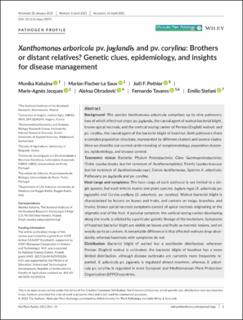Please use this identifier to cite or link to this item:
https://doi.org/10.21256/zhaw-22796| Publication type: | Article in scientific journal |
| Type of review: | Peer review (publication) |
| Title: | Xanthomonas arboricola pv. juglandis and pv. corylina: Brothers or distant relatives? : genetic clues, epidemiology, and insights for disease management |
| Authors: | Kałużna, Monika Fischer‐Le Saux, Marion Pothier, Joël Jacques, Marie‐Agnès Obradović, Aleksa Tavares, Fernando Stefani, Emilio |
| et. al: | No |
| DOI: | 10.1111/mpp.13073 10.21256/zhaw-22796 |
| Published in: | Molecular Plant Pathology |
| Volume(Issue): | 22 |
| Issue: | 12 |
| Page(s): | 1481 |
| Pages to: | 1499 |
| Issue Date: | 22-Jun-2021 |
| Publisher / Ed. Institution: | Wiley |
| ISSN: | 1464-6722 1364-3703 |
| Language: | English |
| Subjects: | Xanthomonas arboricola; Bacterial blight; Hazelnut; Walnut |
| Subject (DDC): | 579: Microbiology |
| Abstract: | Background: The species Xanthomonas arboricola comprises up to nine pathovars, two of which affect nut crops: pv. juglandis, the causal agent of walnut bacterial blight, brown apical necrosis, and the vertical oozing canker of Persian (English) walnut; and pv. corylina, the causal agent of the bacterial blight of hazelnut. Both pathovars share a complex population structure, represented by different clusters and several clades. Here we describe our current understanding of symptomatology, population dynamics, epidemiology, and disease control. Taxonomic status: Bacteria; Phylum Proteobacteria; Class Gammaproteobacteria; Order Lysobacterales (earlier synonym of Xanthomonadales); Family Lysobacteraceae (earlier synonym of Xanthomonadaceae); Genus Xanthomonas; Species X. arboricola; Pathovars: pv. juglandis and pv. corylina. Host range and symptoms: The host range of each pathovar is not limited to a single species, but each infects mainly one plant species: Juglans regia (X. arboricola pv. juglandis) and Corylus avellana (X. arboricola. pv. corylina). Walnut bacterial blight is characterized by lesions on leaves and fruits, and cankers on twigs, branches, and trunks; brown apical necrosis symptoms consist of apical necrosis originating at the stigmatic end of the fruit. A peculiar symptom, the vertical oozing canker developing along the trunk, is elicited by a particular genetic lineage of the bacterium. Symptoms of hazelnut bacterial blight are visible on leaves and fruits as necrotic lesions, and on woody parts as cankers. A remarkable difference is that affected walnuts drop abundantly, whereas hazelnuts with symptoms do not. Distribution: Bacterial blight of walnut has a worldwide distribution, wherever Persian (English) walnut is cultivated; the bacterial blight of hazelnut has a more limited distribution, although disease outbreaks are currently more frequently reported. X. arboricola pv. juglandis is regulated almost nowhere, whereas X. arboricola pv. corylina is regulated in most European and Mediterranean Plant Protection Organization (EPPO) countries. Epidemiology and control: For both pathogens infected nursery material is the main pathway for their introduction and spread into newly cultivated areas; additionally, infected nursery material is the source of primary inoculum. X. arboricola pv. juglandis is also disseminated through pollen. Disease control is achieved through the phytosanitary certification of nursery material (hazelnut), although approved certification schemes are not currently available. Once the disease is present in walnut/hazelnut groves, copper compounds are widely used, mostly in association with dithiocarbamates; where allowed, antibiotics (preferably kasugamycin) are sprayed. The emergence of strains highly resistant to copper currently represents the major threat for effective management of the bacterial blight of walnut. |
| URI: | https://digitalcollection.zhaw.ch/handle/11475/22796 |
| Fulltext version: | Published version |
| License (according to publishing contract): | CC BY-NC 4.0: Attribution - Non commercial 4.0 International |
| Departement: | Life Sciences and Facility Management |
| Organisational Unit: | Institute of Natural Resource Sciences (IUNR) |
| Published as part of the ZHAW project: | Comparative genomics of the plant pathogen Xanthomonas arboricola pv. pruni and related xanthomonads |
| Appears in collections: | Publikationen Life Sciences und Facility Management |
Files in This Item:
| File | Description | Size | Format | |
|---|---|---|---|---|
| 2021_Kaluzna-etal_Xanthomonas-arboricola-pv-juglandis-and-pv-corylina.pdf | 2.12 MB | Adobe PDF |  View/Open |
Show full item record
Kałużna, M., Fischer‐Le Saux, M., Pothier, J., Jacques, M.-A., Obradović, A., Tavares, F., & Stefani, E. (2021). Xanthomonas arboricola pv. juglandis and pv. corylina: Brothers or distant relatives? : genetic clues, epidemiology, and insights for disease management. Molecular Plant Pathology, 22(12), 1481–1499. https://doi.org/10.1111/mpp.13073
Kałużna, M. et al. (2021) ‘Xanthomonas arboricola pv. juglandis and pv. corylina: Brothers or distant relatives? : genetic clues, epidemiology, and insights for disease management’, Molecular Plant Pathology, 22(12), pp. 1481–1499. Available at: https://doi.org/10.1111/mpp.13073.
M. Kałużna et al., “Xanthomonas arboricola pv. juglandis and pv. corylina: Brothers or distant relatives? : genetic clues, epidemiology, and insights for disease management,” Molecular Plant Pathology, vol. 22, no. 12, pp. 1481–1499, Jun. 2021, doi: 10.1111/mpp.13073.
KAŁUŻNA, Monika, Marion FISCHER‐LE SAUX, Joël POTHIER, Marie‐Agnès JACQUES, Aleksa OBRADOVIĆ, Fernando TAVARES und Emilio STEFANI, 2021. Xanthomonas arboricola pv. juglandis and pv. corylina: Brothers or distant relatives? : genetic clues, epidemiology, and insights for disease management. Molecular Plant Pathology. 22 Juni 2021. Bd. 22, Nr. 12, S. 1481–1499. DOI 10.1111/mpp.13073
Kałużna, Monika, Marion Fischer‐Le Saux, Joël Pothier, Marie‐Agnès Jacques, Aleksa Obradović, Fernando Tavares, and Emilio Stefani. 2021. “Xanthomonas Arboricola Pv. Juglandis and Pv. Corylina: Brothers or Distant Relatives? : Genetic Clues, Epidemiology, and Insights for Disease Management.” Molecular Plant Pathology 22 (12): 1481–99. https://doi.org/10.1111/mpp.13073.
Kałużna, Monika, et al. “Xanthomonas Arboricola Pv. Juglandis and Pv. Corylina: Brothers or Distant Relatives? : Genetic Clues, Epidemiology, and Insights for Disease Management.” Molecular Plant Pathology, vol. 22, no. 12, June 2021, pp. 1481–99, https://doi.org/10.1111/mpp.13073.
Items in DSpace are protected by copyright, with all rights reserved, unless otherwise indicated.